In digital innovation, where every line of code and pixel holds the potential to transform industries and simplify lives, the anticipation of unveiling a new app, software, or website is nothing short of exhilarating. Yet, in this era of rapid technological advancement, the journey from creation to global launch is paved with a critical checkpoint that stands between success and setbacks: Beta Testing.
According to recent industry reports, a staggering 88% of users are less likely to return to a website or app after a bad experience, while 42% would share their negative experiences with others.
This paints a vivid picture of the critical role beta testing plays in not just shaping a product’s functionality, but also in safeguarding its reputation.
From the gaming industry, where 64% of developers rely on beta testing for refining gameplay dynamics, to the world of mobile apps, where beta testing reduces app crash rates by up to 80%, the practice resonates across domains.
In this blog, we delve into the multifaceted world of beta testing, uncovering its importance, best practices, pitfalls to avoid, and the industries that thrive on its insights.
Therefore, let’s get right into it:
What is Beta Testing?

Let us introduction you to beta testing.
Picture this:
You’ve invested endless hours and boundless creativity in app development or website development that holds the promise of reshaping an industry or simplifying daily routines.
The prospect of unleashing your solution upon the world is electrifying, but ensuring it’s as polished as a gem before the grand unveiling is important.
This is precisely where beta testing enters the stage – a pivotal phase in whole mobile app testing process where your meticulously developed product is placed into the hands of a carefully selected group of users.
In addition, these users explore, interact, and, most importantly, provide feedback.
Moreover, this user-centric approach serves as a magnifying glass, revealing glitches, usability intricacies, and unexpected user experiences that might have eluded even the most rigorous internal testing procedures.
Moving on, let’s see why is beta testing important in the section below.
Why is Beta Testing Important?
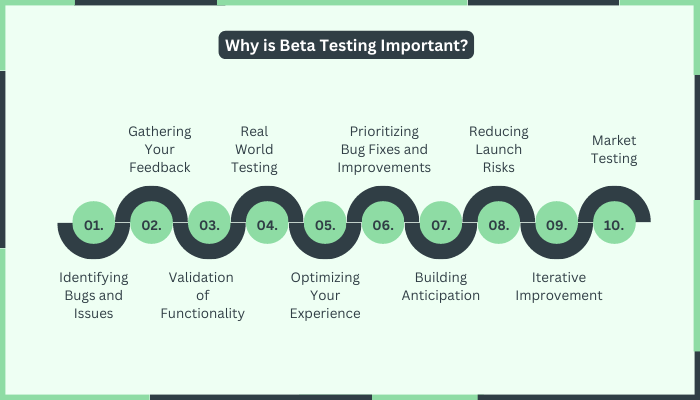
So, why is the beta testing important for any form of software development? Well, there are a number of reasons for that.
And we shall be going through these examples in this section of the blog:
Identifying Bugs and Issues
Beta testing lets you use the product in real-world scenarios and helps uncover any bugs, glitches, or issues that might not have been found during internal testing.
Gathering Your Feedback
Your feedback as a beta tester provides valuable insights. Your unique perspective helps the developers understand how the product performs and whether it meets your expectations and requirements.
Validation of Functionality
Beta testing ensures that the product’s features work as intended, giving you confidence in its capabilities.
Real-World Testing
You help test the product in real-world conditions, which can reveal issues that might not have come up in controlled testing environments.
Optimizing Your Experience
Your input helps improve the user experience by identifying pain points and areas where the product can be enhanced to better suit your needs.
Prioritizing Bug Fixes and Improvements
Your feedback helps prioritize which issues should be addressed first, ensuring that your concerns are taken seriously.
Building Anticipation
Beta testing gives you an early look at the product, making you feel more excited and invested in its success.
Reducing Launch Risks
Your participation in beta testing helps catch and fix problems before the official launch, ensuring a smoother experience for you and other users.
Iterative Improvement
Your involvement in beta testing allows for iterative improvements based on your feedback, leading to a better end product.
Market Testing
Beta testing helps determine if the product resonates with you and the intended audience, ensuring that it’s something you’ll find valuable.
Alpha Testing vs Beta Testing
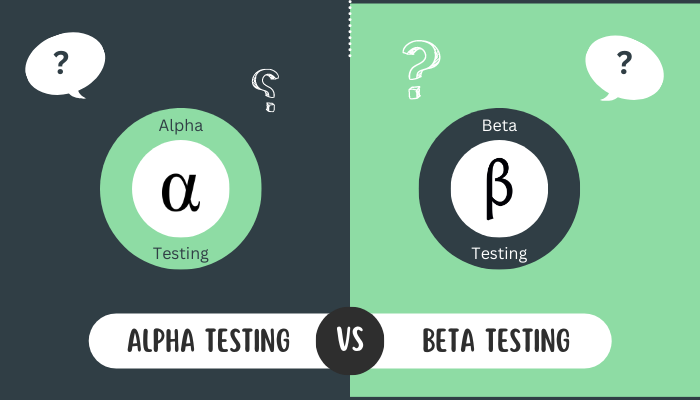
If you have been through – let’s say – app development process, you might have heard of something called, “Alpha Testing”.
Well, we shall be discussing Alpha Testing vs Beta Testing.
But first, let’s understand what alpha testing is.
In the world of app and web development, alpha testing represents the initial phase of testing.
It’s like an exclusive sneak peek where the application is tested by an internal team, often the developers themselves, before it reaches a wider audience.
The purpose of alpha testing is to identify bugs, glitches, and issues within the application’s core functionalities.
This phase primarily focuses on validating the software’s basic functionality, ensuring that it works as intended.
Alpha Testing vs Beta Testing
- Testing Audience: Alpha testing involves internal teams and developers, while beta testing expands to external users from the target audience.
- Scope: Alpha testing emphasizes core functionalities, while beta testing examines broader aspects, including usability and user feedback.
- Environment: Alpha testing usually occurs in a controlled environment, while beta testing takes place in a more diverse and real-world setting.
- Purpose: Alpha testing’s primary goal is to catch foundational bugs, whereas beta testing focuses on refining user experience and finding any overlooked issues.
- Confidentiality: Alpha testing is often kept confidential, with a limited number of participants, while beta testing might involve a larger, but still controlled, audience.
With this out of the way, let’s see the use cases, If you will, for beta testing.
When To Go For Beta Testing

So, let’s answer one of the most important question, when do you use beta testing?
Well, there are a lot of cases when you can use beta testing and get a lot of benefits out of this. Let’s look at the same below:
1. Software Development
When you’re going for software development, beta testing allows you to release a version to a limited group of users.
This helps identify any bugs, glitches, or usability issues that might have been missed during the development phase.
2. Gaming Industry
If you’re a game developer or fantasy sports app developers, beta testing lets you release a preview of your game to players before the official launch.
This helps gather feedback on gameplay, balance, and any potential technical issues.
3. Mobile Apps
When considering mobile app development, beta testing helps you gather insights from real users about the app’s performance, user interface, and overall experience.
This way, you can make improvements before the app hits the app stores.
4. Website Development
Beta testing a website involves releasing it to a select group of users to identify any issues related to navigation, load times, broken links, and overall user experience.
This makes beta testing an important aspect of web development.
5. Medical Software
In the field of healthcare, beta testing medical app development is crucial to ensure that it’s accurate, reliable, and safe for use by medical professionals.
This helps catch any potential errors that could have serious consequences.
6. Virtual Reality (VR) and Augmented Reality (AR)
Developers of VR and AR applications often rely on beta testing to fine-tune the immersive experience, detect motion sickness triggers, and gather feedback on the overall sensation.
7. Online Services
Companies offering online services, such as streaming platforms or cloud-based software, can use beta testing to ensure their servers can handle the anticipated user load and to identify any performance bottlenecks.
Remember, beta testing is all about involving real users and collecting their feedback to make your product as polished and user-friendly as possible before it’s released to the broader audience.
Beta Testing Process
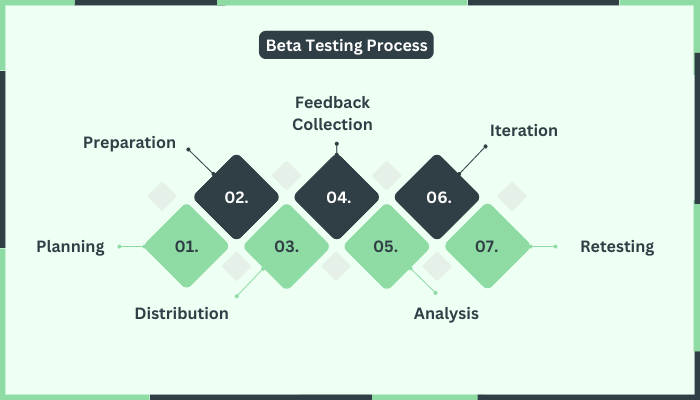
With that out of the way, let’s look at the process that goes behind beta testing. The steps for beta testing are, as mentioned below:
1. Planning
The initial step involves charting out a comprehensive beta testing plan.
Define your objectives for this phase, select a representative group of beta testers that mirrors your target audience. And create a roadmap that outlines the entire testing process.
2. Preparation
Prepare your product for the beta testing phase.
This includes creating a stable version that is ready for external scrutiny, setting up effective feedback channels to capture tester inputs, and ensuring clear communication channels for any queries.
3. Distribution
At this stage, you release your app or website to your selected beta testers.
It’s essential that they have access to all relevant documentation, guidelines, and instructions for optimal usage.
4. Feedback Collection
Encourage your beta testers to engage extensively with your creation.
Their feedback could encompass everything from identifying technical glitches and usability concerns to offering suggestions for improvement.
5. Analysis
With a deluge of feedback at your disposal, it’s time to analyze the inputs received.
Categorize the issues based on their severity and frequency, which aids in prioritizing the required fixes.
6. Iteration
Armed with insights from your testers, you can now implement the necessary changes to address the identified issues.
This might encompass bug fixes, enhancements to the user interface and experience, and even the incorporation of new features.
7. Retesting
After implementing the changes, it’s crucial to conduct retesting to verify that the issues highlighted during beta testing have been successfully resolved.
This stage ensures that your product is on a trajectory of continuous improvement.
Mistake To Avoid in Beta Testing
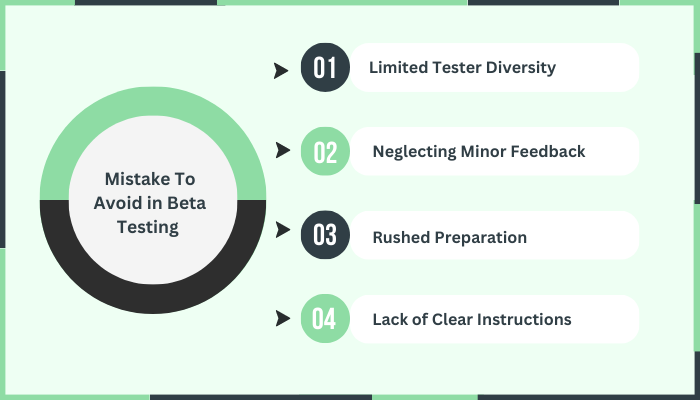
Mistake To Avoid in Beta Testing
While beta testing is a treasure trove of insights, there are several pitfalls that you should sidestep to ensure the efficacy of this phase:
- Limited Tester Diversity: Don’t restrict your tester pool to a small circle. Embrace diversity in terms of backgrounds, experiences, and perspectives. This fosters a wider spectrum of feedback.
- Neglecting Minor Feedback: Each piece of feedback, no matter how seemingly minor, contributes to the larger puzzle of product enhancement. Valuable insights might be buried within those seemingly innocuous suggestions.
- Rushed Preparation: Jumping into beta testing without meticulous preparation can lead to chaos and ineffective feedback collection. Thorough groundwork is the key to a successful beta testing phase.
- Lack of Clear Instructions: Beta testers need clear guidelines on how to explore your product and how to effectively report issues. In the absence of this, their feedback might lack structure and consistency.
Beta Testing Best Practices
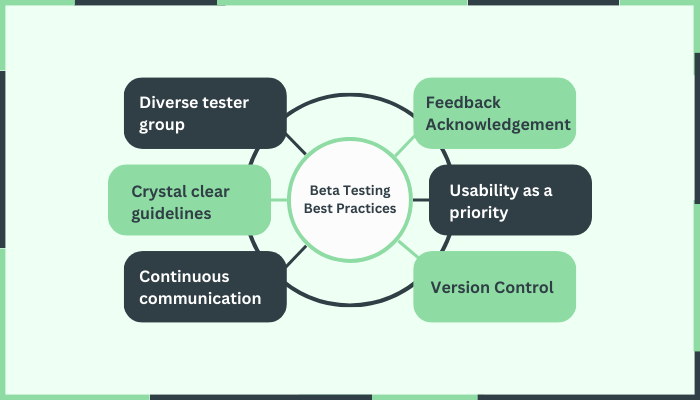
Beta Testing Best Practices
Now that we are done with the mistakes to avoid, it’s time to discuss the beta testing best practices. Therefore, with this being said, let’s get right into it:
1. Diverse Tester Group
A heterogeneous group of testers ensures a diverse range of perspectives. This facilitates the uncovering of a broader array of issues and preferences.
2. Crystal-Clear Guidelines
Provide testers with comprehensive instructions on using your product and reporting issues. This precision empowers them to offer structured and actionable feedback.
3. Continuous Communication
Maintain an open and constant line of communication with your testers. Promptly address their queries, acknowledge their feedback, and keep them engaged throughout the process.
4. Version Control
In the dynamic realm of beta testing, maintaining version control is essential. This practice helps in tracking the evolution of your product and precisely identifying when specific issues were resolved.
5. Usability as a Priority
Beta testing extends beyond the realm of bug detection. Focus on assessing the ease with which users navigate your product and achieve their intended tasks.
6. Feedback Acknowledgment
A culture of appreciation goes a long way. Acknowledging your testers’ contributions fosters a positive testing environment, encouraging them to remain engaged and invested.
Conclusion
In the ever-evolving landscape of innovation, beta testing emerges as the unsung hero, refining and perfecting digital creations.As the bridge between conception and reality, beta testing not only catches bugs but also cultivates user-centric experiences.
With its power to unveil imperfections before the world, beta testing ensures that products launch with confidence, making a lasting impact on industries and users alike. Embrace the iterative journey of beta testing; it’s the compass that guides creations from good to exceptional.
FAQ
Beta testers are volunteers or users who try out the product, providing valuable insights and reporting any problems they encounter.
Choose a diverse group of testers, clearly define testing objectives, provide guidelines, and use feedback tools to track issues and suggestions.
Beta testing occurs after internal testing and just before the product launch, allowing time to address issues and make improvements.
Beta testing enhances product quality, user satisfaction, and reduces the chances of post-launch problems, ultimately leading to a more successful launch.
No, beta testing applies to software, hardware, websites, games, mobile apps, and even services, ensuring quality across various domains.
The duration varies based on the complexity of the product. It can range from a few weeks to a couple of months.
Skipping beta testing may lead to unexpected issues and user dissatisfaction. It’s a crucial step to ensure a solid product launch.
Select testers who represent your target audience, including both experienced users and newcomers, to obtain diverse feedback.
After beta testing, you’ll analyze feedback, fix identified problems, and make necessary adjustments before the official product launch.
Beta testing is the last testing phase before launch, but continuous monitoring and updates post-launch are essential for ongoing improvement.

Niketan Sharma is the CTO of Nimble AppGenie, a prominent website and mobile app development company in the USA that is delivering excellence with a commitment to boosting business growth & maximizing customer satisfaction. He is a highly motivated individual who helps SMEs and startups grow in this dynamic market with the latest technology and innovation.
Table of Contents












No Comments
Comments are closed.